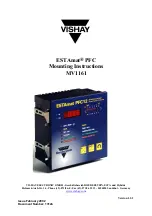
Issue February 2002
Document Number: 13124
- 9 -
3. Connection of the
ESTAmat PFC Controller
3.1. Terminals allocation
The power factor controller is connected by means of a 20-terminal plug. The
ESTAmat PFC12
is
provided with an additional 6-terminal plug for the steps 7 to 12. The connections are shown at the
rear of the power factor controller's casing.
Terminal allocation of the plug:
Terminals
Connection
1
C.T. connection
k (S1)
, X/5 A or X/1 A
2
C.T. connection
l (S2)
, X/5 A or X/1 A
4
supply connection
N
, 230 VAC
5
supply connection
L1
, 230 VAC
7, 8
potential-free fault alarm contact, normally open
10
measuring voltage L or N
12
measuring voltage L
15-20
control outputs for contactors 1-6
21-26
control outputs for contactors 7-12 (only PFC12)
3.2. General connection instructions
1
. The power factor controller is internally protected by means of a fine-wire fuse 100 mA (glass
tube fuse 5 x 20 mm). This fuse is not accessible from the outside.
2
. The rating of the external fuse is a function of the current consumption of the connected
contactors. It should, however, be taken into account that an individual control contact may
certainly be loaded with a maximum of 5A, but the external fuse must not exceed the value of
10A.
3.
Under normal circumstances, the measuring voltage is identical with the operating voltage, i.e. the
terminals 4-10 and 5-12 shall be connected by means of bridging links. If measuring voltage and
operating voltage are connected separately, the terminals 10 and 12 are each to be protected by a
quick-acting fuse of 2 A.
4.
All control contacts, except for the fault alarm contact (7 and 8), are bridged by a spark-quenching
unit (RC element). The impedance of the RC element is 30 k
Ω
at 50 Hz.
5.
When using capacitors with attached discharge resistors, the necessary time for discharging will
be 60 or 180 seconds, which has to be observed for any switching-in of steps. The re-switching
blocking delay time of the ESTAmat PFC must be set accordingly via parameter 7.
3.3. Connection instructions for current transformer
1.
In case of an unbalanced load of the phases, the current transformer should be connected to the
phase which is most highly loaded.


























